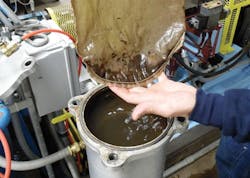About the author: Dave Peterson is business development manager for Spiral Water. Peterson can be reached at [email protected].
A county utility in eastern Washington state operates a new-generation micro-hydroelectric plant that delivers power generated by local rivers and streams. Designed as an energy-efficient solution, the plant was experiencing an undesirable amount of downtime. Plant efficiency was affected by the high total suspended solids (TSS) in the water source, the Skykomish River, which is subject to seasonal upset when weather and environmental conditions increase turbidity.
The plant relied on 200-µ bags to filter the water used to cool bearings and mechanical seals on the plant’s two system turbines. The bags filled to capacity on an irregular basis, depending on river conditions, requiring plant employees to travel to the unmanned facility to manually clean or replace them. Because clogged filters and bag replacement require operational stoppage, the plant had to keep employees on-call 24 hours a day to minimize plant downtime.
As with other industrial applications, the service water requirements for removal of smaller particles like grit and sand are critical to the protection of the plant’s turbine bearings and pump seals. Heat exchangers used for lubricating oil cooling offer better performance if the heat transfer surfaces are kept clean and silt-free. A thin coating of silt is an insulator that cuts down on the performance of the heat exchanger.
Conventional strainers can only provide protection above 100-µ retention. Often the strainers used are in the 400-µ range because of the high TSS of the debris. Strainers using a woven wire mesh element are problematic if algae are present, as the algae can weave into the structure and become difficult to remove. Automatic self-cleaning strainers are used to reduce maintenance, usually through backwashing, with the pore size of the element opened so as not to exceed the low TSS it can handle.
Conventional automatic strainers are limited to a maximum TSS of about 200 ppm. They can stay within this limitation by collecting only the largest particles, letting the majority of smaller particles pass through.
Replacing Bag Filters
Spiral Water Technologies, a California company specializing in difficult-to-treat waters, assessed the operation at the Washington facility in the fall of 2015. After making its recommendations, Spiral Water installed a 50-µ SWT filter inline prior to the plant’s mechanical seal water delivery. The SWT is an automatic self-cleaning water filter for ultra-high and variable TSS of up to 25,000 ppm. The helical action of the filter is able to handle up to 100 times dirtier water and provide continuous 10- to 100-µ filtration with 90% less energy usage than traditional filtration systems. The installation took approximately four hours and did not require removal of the existing bag filters or any system overhaul.
In addition to providing low-micron filtration, the filter system automatically collects, condenses and purges solids, eliminating the need to manually replace filter bags. This allowed the utility to improve employee efficiency and reduce costly operational downtime.
The plant had been using the existing bag filter system for years. Work stoppages were common and cut into operation performance, but as with other hydropower plants, it was considered standard procedure.
Having operated the Spiral Water system through the river’s most variable seasonal conditions, the plant facilities manager declared it a successful upgrade. “The Spiral Water automatic self-cleaning filter lets us keep the operation flowing, without the need for constant filter maintenance,” he said.
Industry-Specific Solutions
Rapid advancements in automatic water filtration are likely to impact the operation of larger hydropower plants and other industrial applications working with high-solids water processes. Many strainers at use in major facilities date back to the 1960s.
Hydropower utility water filtration considerations include:
- Better protection of turbine bearing surfaces, pump seals and heat exchangers;
- Algae protection. Spiral Water’s technology was developed as an algae-harvesting device with a government grant for production of biofuels, and is not affected by algae and other deformable solids; and
- Protection from invasive species like zebra and quagga mussel larvae, currently impacting Colorado River operations. The 25-µ filters and automatic purging enable the filter systems to capture and destroy mussel larvae.
Industrial surface water and groundwater filtration involves a handful of factors, including the removal of grit and sand from well water sources for industrial process makeup and cooling water. Conventional strainers have limitations on micron retention. Finer filtration technologies like bag filters and cartridges have limited dirt-holding capability and high operating costs for media, labor and disposal of spent media.
Process industry wastewater sources also can benefit from finer filtration, cutting down solids-loading on facility wastewater systems or biological oxygen demand into municipal waste systems. Process water can be filtered for collection and consolidation of solids, which in some cases might not be a waste stream, but a valuable product that can be recovered for resale.
This filtration technology also can be used for other water applications, including:
- Cooling tower water treatment systems;
- Seawater treatment and reverse osmosis;
- Fish farm water treatment systems;
- Irrigation water and fertilizer spray nozzle protection;
- Leach mining emitter protection; and
- Spray nozzle protection in general industry and municipal wastewater plants.
Conclusion
The Washington micro-hydroelectric case demonstrated the ability of the automatic filtration system to improve plant efficiency through its ability to capture high-variable solids subject to erratic seasonal extremes. Though small in scope and volume, the same technology and design solution applies to much larger hydroelectric and industrial applications, and other difficult-to-treat waters and equipment requirements. With increasing demand for better operating efficiencies, advanced water filtration will continue to be a source of innovation.
Download: Here
